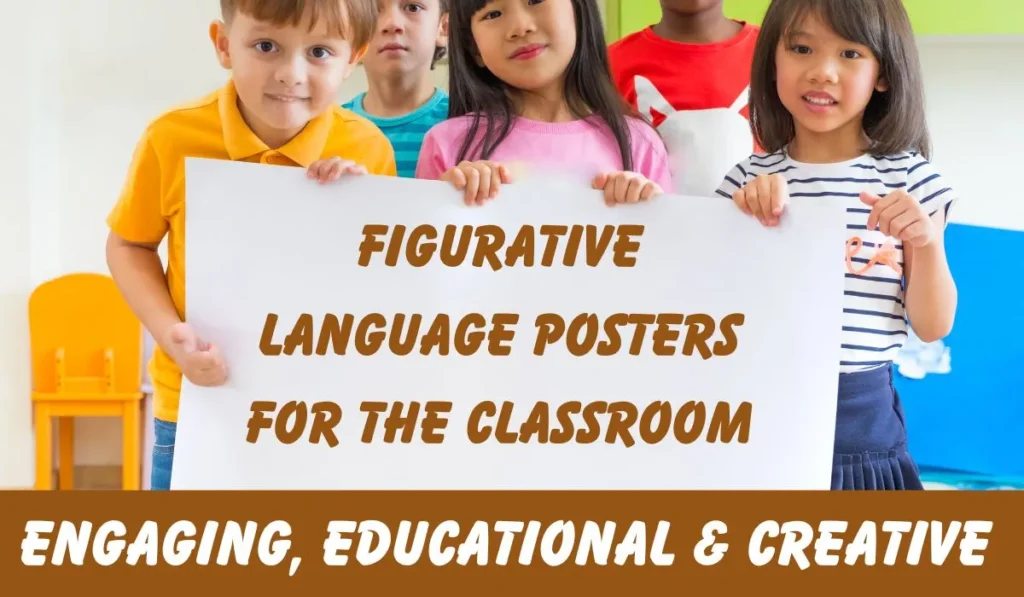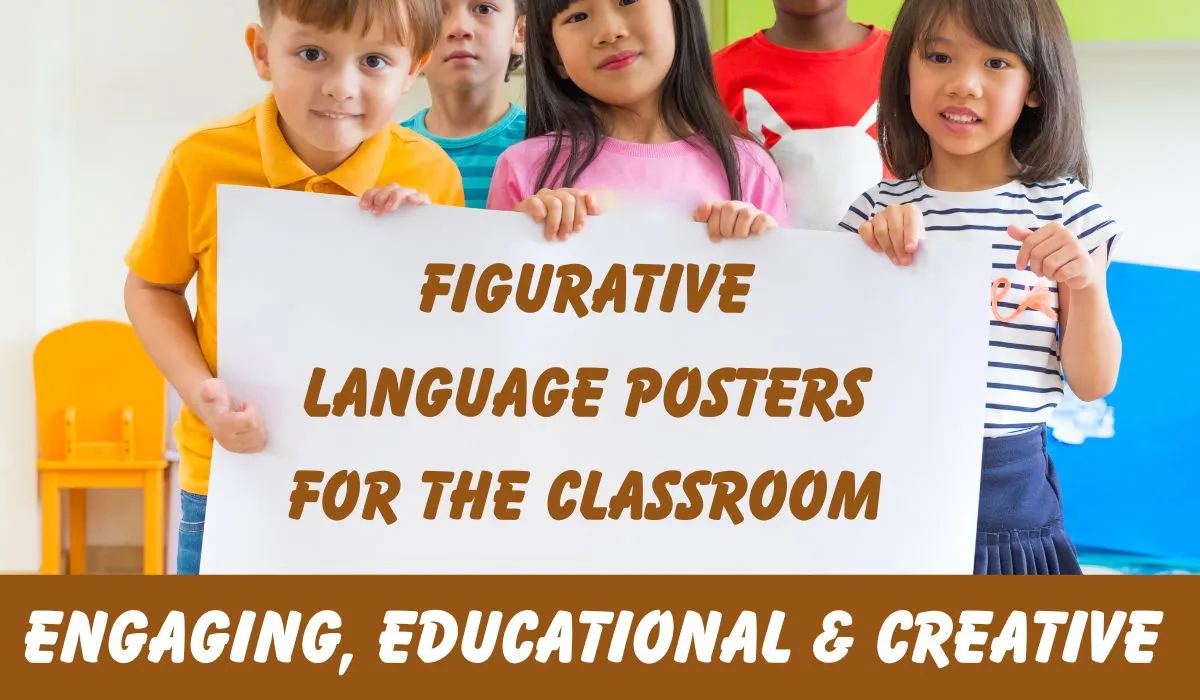
Figurative language posters are a fantastic addition to any classroom, providing visual cues to help students grasp complex literary concepts. These engaging tools can transform a learning environment, making it vibrant and educational while reinforcing key language arts concepts.
What is Figurative Language?
Figurative language is a literary device used to convey meanings beyond the literal interpretation of words. It helps writers express ideas in more imaginative and vivid ways. Some common types include:
- Simile: Comparing two things using “like” or “as.” Example: “Her smile was as bright as the sun.”
- Metaphor: Directly comparing two unrelated things. Example: “Time is a thief.”
- Hyperbole: Exaggeration for effect. Example: “I’ve told you a million times!”
- Personification: Giving human qualities to non-human objects. Example: “The wind whispered through the trees.”
- Alliteration: The repetition of the same initial consonant sound in a series of words.
- Example: “Peter Piper picked a peck of pickled peppers.”
- Onomatopoeia: Words that imitate natural sounds.
- Example: “The bacon sizzled on the pan.”
- Idioms: Phrases with meanings different from their literal interpretations.
- Example: “It’s raining cats and dogs.”
- Oxymoron: A combination of contradictory terms.
- Example: “Bittersweet memories.”
- Imagery: Descriptive language that appeals to the senses.
- Example: “The fragrance of freshly baked bread filled the air.”
- Symbolism: Using symbols to represent abstract ideas.
- Example: “The dove symbolizes peace.”
The Importance of Figurative Language in Education
Understanding and using figurative language is essential for developing reading comprehension, literary analysis, and creative writing skills.
Impact on Student Learning
Research shows that students who are proficient in recognizing figurative language perform better in reading comprehension assessments. According to a recent study, classrooms that actively teach literary devices see a 25% improvement in reading engagement and analysis.
Engagement in the Classroom
Figurative language posters can enhance classroom decor while serving as constant visual reminders. Teachers can use them to spark discussions, reinforce lessons, and even inspire creative assignments.
Types of Figurative Language Posters
There are many creative ways to design figurative language posters. Below are some popular types:
Simile and Metaphor Posters
These posters can feature vibrant visuals that highlight comparisons. Example: a poster showing a roaring lion with the caption “His voice was a lion’s roar.” Design elements might include bold fonts and illustrative graphics.
Idioms and Hyperbole Posters
Creative visuals can help clarify idiomatic expressions like “It’s raining cats and dogs” or hyperboles such as “I’m so hungry I could eat a horse.” Bright colors and cartoon illustrations work well for these.
Personification and Other Literary Devices
Posters can visually represent concepts like personification (“The sun smiled down on us”) or alliteration (“Peter Piper picked a peck of pickled peppers”). Including eye-catching designs helps these concepts stick.
How to Create Effective Figurative Language Posters
Creating impactful posters requires thoughtful design and content planning.
Focus on Clarity and Visual Appeal
- Use large, readable fonts.
- Incorporate bright colors and high-quality images.
- Ensure the design is not cluttered and visually balanced.
Incorporate Examples and Definitions
- Provide concise definitions alongside clear examples.
- Use relatable scenarios to make the content more accessible.
Resources and Tools
Teachers can access numerous resources and tools for creating or sourcing figurative language posters.
Graphic Design Software
- Canva: Easy-to-use platform with customizable templates.
- Adobe Spark: Professional-quality design options.
Educational Websites
- Teachers Pay Teachers: A treasure trove of ready-made resources.
- Educational Blogs: Many language arts-focused blogs offer free poster templates.
Where to Find Ready-Made Figurative Language Posters
If designing from scratch isn’t feasible, plenty of options are available.
Bundle Reviews and Comparisons
- Free Downloads: Websites like Pinterest often have free resources.
- Premium Resources: Investing in high-quality bundles from educational marketplaces can be worthwhile for comprehensive sets.
Additional Teaching Strategies Using Posters
Posters aren’t just decorative; they can be integral to lesson plans:
- Interactive Activities: Have students create figurative language examples inspired by the posters.
- Discussion Starters: Use posters to initiate conversations about literary devices in books and media.
- Creative Writing Prompts: Encourage students to incorporate specific figurative language types into their writing.
Conclusion
Figurative language posters are invaluable tools for fostering a creative and engaging learning environment. They enhance students’ understanding of complex literary concepts and bring vibrancy to the classroom. Teachers can explore various design tools and resources or invest in ready-made products to get started. For more creative classroom ideas and resources, consider subscribing to educational newsletters or visiting trusted teaching blogs.
Figurative Language Posters Pdf Free
Enhancing your understanding of figurative language can be both engaging and visually appealing with the help of free, downloadable posters. Here are some resources where you can access such materials:
- This Reading Mama offers a set of 12 free figurative language posters, each illustrating a different concept with definitions and examples.
- Jennifer Findley provides free figurative language posters suitable for grades 4-5, covering seven types: simile, metaphor, personification, hyperbole, idiom, alliteration, and onomatopoeia.
- The Teacher Next Door offers free figurative language posters, each focusing on a specific type, including similes, idioms, metaphors, hyperboles, proverbs, allusions, alliterations, and personifications.
- Kirsten’s Kaboodle provides a freebie that includes posters for metaphors, similes, idioms, hyperboles, proverbs and adages, personification, alliteration, puns, and onomatopoeia.
- The Sydney Teacher offers a free set of eight figurative language posters in both color and black-and-white versions, covering alliteration, onomatopoeia, idiom, simile, oxymoron, hyperbole, metaphor, and personification.
Figurative language posters for middle school
Here are some creative ideas for figurative language posters suitable for middle school classrooms:
1. Simile Poster: “Comparisons that Shine!”
- Tagline: “As bright as the sun or as cool as ice—similes compare things using ‘like’ or ‘as.'”
- Visuals: Include illustrations of examples such as “Her smile is like sunshine.”
2. Metaphor Poster: “Think Beyond Words!”
- Tagline: “Metaphors say one thing is another. No ‘like’ or ‘as’ needed!”
- Visuals: Show examples like “Time is a thief” with fun illustrations.
3. Alliteration Poster: “Amazing, Astonishing, and Awesome!”
- Tagline: “Repeating consonant sounds make language catchy!”
- Visuals: Showcase words like “Peter Piper picked a peck of pickled peppers.”
4. Personification Poster: “Let Objects Come Alive!”
- Tagline: “Give human qualities to animals or objects.”
- Visuals: Show examples like “The wind whispered through the trees.”
5. Hyperbole Poster: “Exaggerate for Effect!”
- Tagline: “Go big or go home!”
- Visuals: Include examples such as “I’m so hungry I could eat a horse.”
6. Onomatopoeia Poster: “Words that Sound Like Sounds!”
- Tagline: “Crash! Boom! Buzz! Hear the words as you read them.”
- Visuals: Include comic-style bubbles for sound words.
7. Idiom Poster: “Say What?”
- Tagline: “Idioms mean something beyond their words.”
- Visuals: Show examples like “It’s raining cats and dogs” with whimsical art.
8. Imagery Poster: “Picture Words in Your Mind!”
- Tagline: “Appeal to the five senses for vivid descriptions.”
- Visuals: Examples like “The sweet scent of freshly baked cookies filled the room.”
FAQs
What is figurative language?
Figurative language uses words or expressions with meanings different from their literal interpretation to create vivid imagery or emphasize ideas.
What are examples of figurative language?
Examples include simile, metaphor, personification, hyperbole, and alliteration.
How can figurative language posters help students?
They visually reinforce concepts, provide examples, and make learning more engaging.
What should be included in a figurative language poster?
Definitions, examples, and illustrations of different figurative language types.
Where can I use figurative language posters?
In classrooms, language workshops, libraries, or study spaces for educational support.
